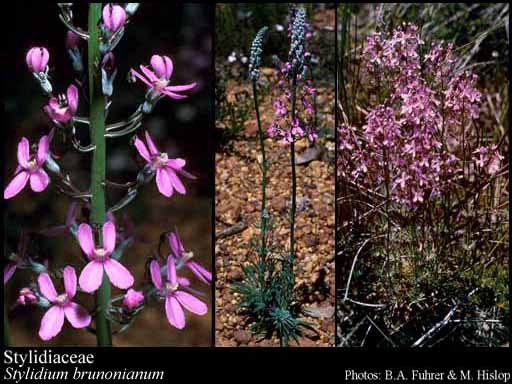- Reference
- Prodr.Fl.Nov.Holland. 565 (1810)
- Name Status
- Current

Scientific Description
Common name. Triggerplant Family.
Habit and leaf form. Herbs, or herbaceous climbers, or shrubs (or shrublets). Perennial; plants with a basal concentration of leaves (often), or with neither basal nor terminal concentrations of leaves, or with terminal rosettes of leaves; rhizomatous, or tuberous. Self supporting (mostly), or climbing (rarely); when scandent, scrambling (Stylidium scandens, via leaf tips recurved into hooks). Helophytic (in bogs), or mesophytic to xerophytic. Leaves alternate (usually, conspicuously so), or whorled (Stylidium scandens); spiral; ‘herbaceous’, or leathery; imbricate; subsessile; sheathing; simple. Leaf blades entire; linear (grasslike); parallel-veined; without cross-venules. Leaves without stipules. Leaf anatomy. Hydathodes present (occasionally), or absent. Stem anatomy. Secondary thickening anomalous; from a single cambial ring.
Reproductive type, pollination. Fertile flowers hermaphrodite, or functionally male and functionally female, or functionally male, or functionally female, or hermaphrodite, functionally male, and functionally female. Unisexual flowers present, or absent. Plants hermaphrodite, or monoecious, or polygamomonoecious, or dioecious. Entomophilous. Pollination mechanism characteristically conspicuously specialized (the stylar column springing forcibly from one side when triggered), or unspecialized (Levenhookia).
Inflorescence and flower features. Flowers solitary, or aggregated in ‘inflorescences’; in cymes, in racemes, in spikes, and in corymbs. The terminal inflorescence unit cymose, or racemose. Inflorescences scapiflorous (often), or not scapiflorous; terminal. Flowers bracteate; small to medium-sized; very irregular; resupinate to not resupinate. The floral asymmetry involving the perianth and involving the androecium, or involving the androecium (occasionally the corolla almost regular). Flowers 5 merous; cyclic; pentacyclic. Floral receptacle developing an androphore (the peculiar ‘stylar column’, which bears the stigma and the anthers at its tip, sometimes being thus interpreted), or with neither androphore nor gynophore (if the column is interpreted as a gynostemium). Free hypanthium present. Perianth with distinct calyx and corolla; (7–)10(–12); 2 -whorled; isomerous (usually), or anisomerous. Calyx (2–)5(–7); 1 -whorled; polysepalous, or gamosepalous; imbricate; bilabiate (usually); with the median member posterior. Corolla 5; 1 -whorled; gamopetalous; imbricate (and resupinate or partly so); unequal but not bilabiate (the anterior member often forming a ‘labellum’, often smaller and/or otherwise different from the rest), or regular; white, or pink, or purple. Fertile stamens present, or absent (female flowers). Androecium 2. Androecial members free of the perianth; united with the gynoecium (seemingly forming a column with the style, the stigma and stamens borne at the tip of the column); coherent; 1 - adelphous (via the gynostemium); 1 -whorled (posterior-lateral). Androecium exclusively of fertile stamens. Stamens 2(–3); reduced in number relative to the adjacent perianth. Anthers dehiscing via longitudinal slits; extrorse; tetrasporangiate. Fertile gynoecium present, or absent (male flowers). Gynoecium 2 carpelled. The pistil 1 celled, or 2 celled. Carpels reduced in number relative to the perianth. Gynoecium syncarpous (but sometimes pseudomonomerous by abortion); eu-syncarpous; inferior. Ovary unilocular, or plurilocular; 2 locular (usually), or 1 locular (by abortion of the posterior locule). Gynoecium median. Epigynous disk present, or absent. Styles 1. Stigmas dry type; papillate; Group II type. Placentation when both locules fertile axile. Ovules in the single cavity when only one locule fertile 1, or 4; 15–50 per locule (‘many’); pendulous, or horizontal, or ascending; anatropous.
Fruit and seed features. Fruit fleshy to non-fleshy; dehiscent, or indehiscent (rarely); a capsule; 4–100 seeded (‘few to many’). Seeds endospermic. Endosperm oily. Seeds minute. Cotyledons 2. Seedling. Germination phanerocotylar.
Physiology, biochemistry. Aluminium accumulation not found.
Geography, cytology, number of species. World distribution: Southeast Asia, Malaysia, Australia, New Zealand, southernmost South America. N = 15, 18. 150 species.
Keys
Western Australian Genera and Families of Flowering Plants — an interactive key
T.D. Macfarlane, L. Watson, N.G. Marchant